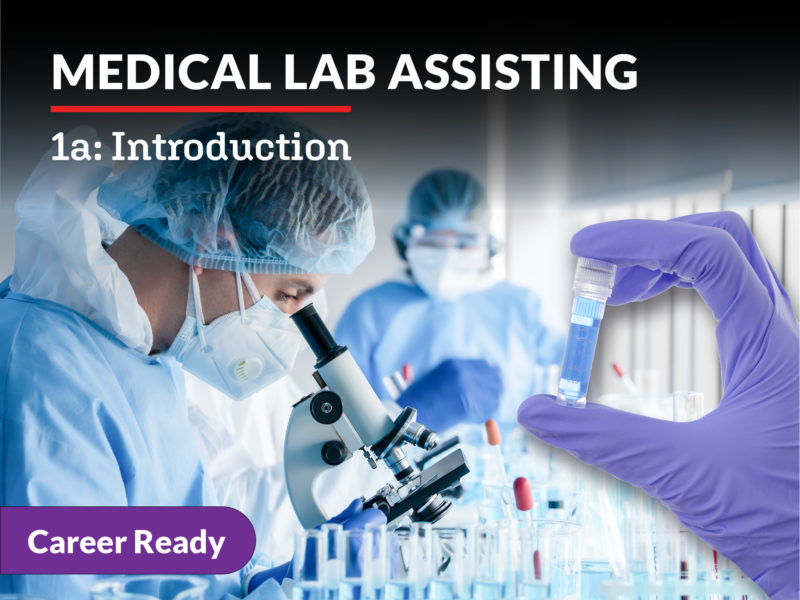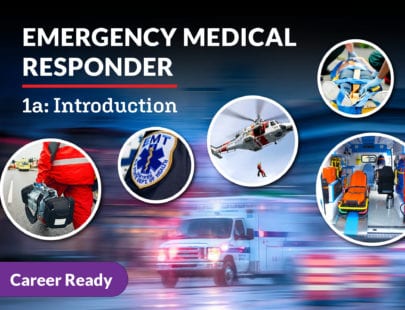
Medical Lab Assisting 1a: Introduction
Getting to the root of medical issues and uncovering ailments is the core of the medical field. Are you drawn to the idea of being part of a team who helps identify diseases and health-related issues? Then the role of a medical lab assistant may be for you! In this course, you will learn what it takes to become a skilled medical lab assistant including understanding medical ethics, communicating with patients, performing blood draws and managing specimens, lab safety, and potential career paths! Grab your lab coat and latex gloves, and let’s draw some new knowledge to help others!
Units at a Glance
Unit 1: Introduction to Medical Lab Assisting
If you’re thinking about a career in health care, medical lab assisting could be just what you’re looking for. As the healthcare industry continues to grow, the demand for medical lab assistants increases. Medical laboratory assistants work in diagnostic labs, hospitals, clinics, and medical practices in every town, city, and part of the country. Unlike becoming a nurse or doctor, you can become a medical lab assistant in months, not years. Medical lab assistants work with a team of other healthcare professionals assisting in the diagnosis of patients and enjoy opportunities for financial and career growth. Sound interesting? Let’s get started!
What will you learn in this unit?
- Describe the roles and responsibilities of a medical lab assistant
- Identify the members of the clinical lab team, including roles, responsibilities, employment options, and training
- Explain workplace options for the medical lab assistant
- Distinguish between the education and requirements necessary for specific health careers, as well as career advancement opportunities for the medical lab assistant
Unit 2: Medical Ethics and Professionalism
In health care, difficult decisions are made each day. How does a medical laboratory assistant learn how to make the right decision? As we begin to explore patient care and what makes a lab work, we’ll look at the ethical codes, guidelines, and regulations that provide the medical laboratory assistant a way to understand the day-to-day complexities they will encounter. These frameworks ensure a smoothly running lab where accountability, respect, and trust are developed between an MLA, their colleagues, and their patients.
What will you learn in this unit?
- Describe the concepts of ethics and professionalism and how they relate to the medical lab assistant
- Define the personal code of conduct of a medical lab assistant
- Explain patient privacy as it is outlined in the Health Insurance Portability and Accountability Act (HIPAA)
- Identify standards, regulations, and laws related to healthcare operations
Unit 3: Communication and Medical Terminology
Those who work in health care seem to speak their own language. Communication is important in any industry but is especially important for those who deal with life and death. In a medical laboratory, effective communication is essential for receiving instructions about which tests are required, ensuring the correct patient and sample, and providing results at the right time to the right person. Communication is more than just talking—communication takes place when you answer the telephone, send an email, or call a physician with a lab result. It also takes place when you roll your eyes, look at your watch, or sit up in your chair and pay attention. An MLA will use communication every single day to convey information to patients and other members of the healthcare team.
What will you learn in this unit?
- Identify the different types of communication utilized in a medical laboratory by an MLA during their daily work
- Discuss the appropriate use of medical terminology in a medical laboratory setting
- Describe methods of communication used to convey information in a laboratory setting, including written communication
- Explain the appropriate use of requisition forms and barcode scanning in a medical laboratory
- Identify the appropriate actions and communication required when responding to various medical emergencies in a healthcare setting
Unit 4: Anatomy and Physiology
An adult human body has about 100,000 miles of blood vessels. Sure, this is an interesting fact, but why is it important to understand? Of the 11 body systems, the circulatory system is the one an MLA will work with every day. It’s time to get up close and personal with the heart, blood vessels, blood, and more. Becoming familiar with the structures and functions of the human body will help you better understand illness and disease prevention. Recognizing which tests are needed for specific diseases and which body system is being evaluated by each test will help you on the job. A solid understanding of the human body is fundamental to any career in health care, but it’s essential to your success as an MLA.
What will you learn in this unit?
- Identify the structure and function of all 11 body systems, including the action of the heart and how blood moves through the circulatory system
- Explain each type of blood vessel and how blood is transported throughout the body
- Describe the components of blood and how lab testing is used to diagnose select blood disorders
- Explain homeostasis, hemostasis, and how coagulation disorders can disrupt homeostasis
Unit 5: Safety and Infection Control
Can you imagine a hospital where no one washes their hands? Where you can dispose of hazardous waste anywhere you please? Let’s hope not! Working in health care is rewarding and fulfilling, but it is not without risk. You will come into contact with certain hazards and infections in the workplace that could expose you or others to disease or injury. Knowing how to manage these risks and maintain a safe environment is essential to anyone working in health care. Are you ready to learn about dangers in the workplace, how infection spreads, how to safely handle hazardous materials, and how to protect yourself from possible contamination or infection? And what do you do if you are exposed to a disease or dangerous substance? Let’s look into the world of safety and infection control, where you play a key role in making your workspace a safer place for all.
What will you learn in this unit?
- Discuss workplace safety regulations and how standards and guidelines are used to ensure safety in a healthcare workplace
- Explain how infection control measures are used to break the chain of infection and stop the spread of pathogens in a healthcare setting
- Describe chemical hazards and explain the importance of safe handling, storage, and disposal of hazardous substances
- Demonstrate the appropriate steps to take if exposure to a hazardous substance occurs
Unit 6: Specimen Handling
You may have heard the saying “a cook is only as good as their ingredients.” The same could be said about specimens: a specimen is only as good as the sample. A quality sample obtained by a conscientious MLA is the first step in determining the overall care of the patient. An MLA handles many different types of specimens as part of their job. You will be helping obtain them, but what happens once you have the specimen in the lab? How do you handle and store different types of specimens? Knowing how to safely handle specimens and keep the integrity of the specimen intact are the keys to obtaining accurate results, protecting you and others from possible exposure, and promoting overall safety in the medical laboratory.
What will you learn in this unit?
- Describe guidelines to follow to obtain a quality lab specimen
- Identify the appropriate blood collection tubes for specific testing
- Explain the purpose of blood cultures and the process for obtaining a blood culture
- Discuss the process of blood banking, blood storage, and transfusions
- Detail how to safely and accurately process, prepare, and package a lab specimen to be shipped
Unit 7: Microbiology
The study of microorganisms, called microbiology, has a long, rich history. The fascination with microorganisms was originally centered on how they caused infectious diseases. This is still an important consideration, but now the study has become much more robust and includes practical applications of the science. As an MLA, you will be working on the identification of different types of pathogens and assisting with specimen preparation to determine the causes of illness. Different techniques are used to identify different types of disease-causing microorganisms. A basic understanding of what these organisms are, how they reproduce, and how they contribute to disease will serve to help you in the preparation of specimens for medical laboratory testing.
What will you learn in this unit?
- Identify and differentiate types of microorganisms that cause disease in humans
- Discuss characteristics of types of bacteria that cause infection in the human body
- Explain procedures for isolating and identifying types of bacteria in a medical laboratory
- Describe procedures for preparing slides of bacteria for microscopic examination
Unit 8: Infectious Disease and Immunology
Which creature is responsible for the most human deaths every year worldwide? Is it the great white shark? Or the king cobra? You might be surprised to learn that it is the humble mosquito! You have learned that microorganisms are on us, in us, and all around us. They inhabit every environment on the planet and can lead to many infections and illnesses. Since mosquitos feed on human and animal blood, they serve as a means of transmission of some of these pathogens, including some that cause deadly illnesses, from one person to another. Let’s learn about how specific microorganisms are isolated in a medical laboratory and how this information is used to control diseases caused by pathogens.
What will you learn in this unit?
- Discuss the study of pathogens and how bacterial sensitivity is determined
- Differentiate types of fungi and describe how fungi cause disease
- Describe viral illness and how viruses are identified in medical laboratories
- Identify types of parasites and how parasitic illness is identified and treated
- Explain testing of human immunology in medical laboratories
Required Materials
Physical
- Calculator
- Audio recording device
- Video recording device
- Paper and pencil
- Crayons, colored pencils, or markers
- Hand hygiene supplies (soap, towel, etc.)
- Camera
Software
- Word processing software
- Presentation software
- Audio editing software
Other
- Infographic template or website
Optional
- Flashcard template software
- Graphic design software



